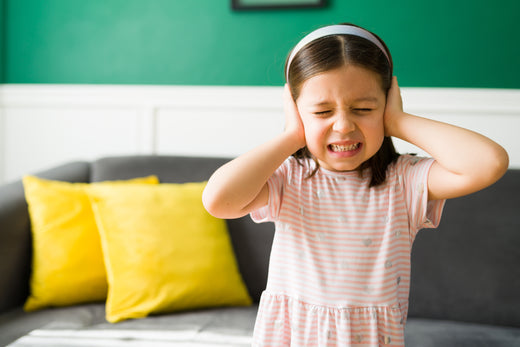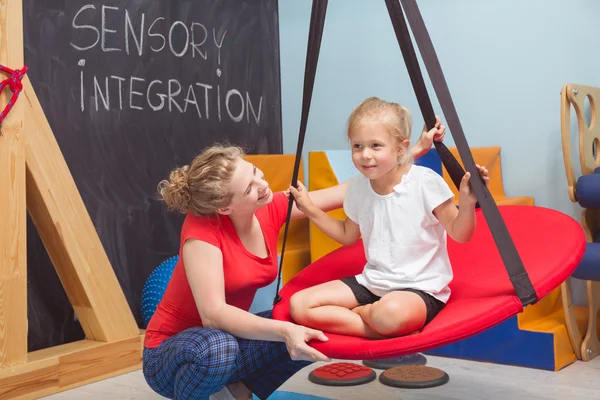Occupational therapy practitioners have been harnessing the benefits of autism sensory swings for years. These swings stimulate a child's proprioceptive and vestibular systems, awakening their senses.

Challenges of Sensory Processing Disorders (SPD) in Children
Children with Sensory Processing Disorders (SPD) find it challenging to filter and organise sensory data. This surplus of information taxes the nervous system, leading to sensory overloads. Sensory inputs such as cuddling and swinging help to soothe the body's instinctive "fight or flight" response. Sensory swings grant your child a sense of security by managing their overstimulated senses.

Importance of the Vestibular System
The vestibular system is a pivotal sensory system in our bodies. It informs our brain about the precise placement of other objects in relation to our body, our direction, speed, and if we're moving. With a fully developed vestibular system, we can navigate confidently through our surroundings.
Improving Balance and Coordination with Sensory Swings
Sensory swings can also improve balance and coordination. When children struggle to assimilate vestibular input, they have trouble manoeuvring their surroundings.
Building Trust and Balance Through Sensory Swings
When your child swings on their sensory swing, they learn their body remains secure even when their feet leave the ground. As these connections become more robust, their balance improves.
Organizing the Brain with Swinging Motion and Deep Pressure Therapy
The swinging motion and Deep Pressure Therapy helps organise the brain. As a result, the overworked nervous system can unwind. The upshot? Sensory shifts help children with autism appear more "balanced." Many parents report that swinging either before or during schoolwork assists with focus.
Key benefits of sensory swings include extending attention span and enhancing coordination.
COMMON SYMPTOMS OF CHILDREN WITH SPD
Children who have sensory processing issues could have trouble locating their bodies. Some typical signs include:
- Motion sickness
- Poor posture
- Clumsiness
- Feeding difficulties
- Crashing to things often
- Trouble performing daily tasks
- Overall weakness
HOW TO UNDERSTAND CHILDREN WITH SPD?
To mitigate the child's frustrations, therapy is often recommended to help them develop self-esteem and independence. Sensory swings are a popular choice for baby shower gift lists.
Swinging is loved by people of various ages; it's not just for kids. For nearly everyone, moving back and forth is soothing. Many people enjoy a nap in a hammock.
The gentle rocking motion makes us feel comforted. Our inner ear has specific receptors that detect motion from all angles. Swinging enhances our perception of motion and spatial orientation by delivering valuable information about movement.
Studies indicate that one in twenty children may have a sensory processing disorder, with a significantly higher prevalence in children with autism. It is believed that sensory processing disorders affect over 75% of autistic children.
Autistic children frequently experience dysregulation, feeling bewildered and overwhelmed in their surroundings. They may overreact or underreact to various sounds, sensations, visuals, tastes, and touch. Many find the gentle rocking and swaying of a swing comforting. They may be better able to concentrate and pay attention during and after physical activity.
WHAT CAUSES SPD?
Although SPD is frequently observed in developmental disorders and has a higher prevalence with autism, preterm, fetal alcohol syndrome, and Down syndrome, there is still no identified etiology. According to a 2006 study, SPD might also have a hereditary component.
Children with ADHD are also significantly more likely to have SPD.
However, SPD can also be a stand-alone diagnosis, meaning sensory processing issues can exist without any other diagnosis.
So how can we assist folks who have trouble digesting sensory data? We must first gain a better understanding of sensory processing and the various sensory inputs we experience. We practice what is known as a sensory diet.
HOW CAN SENSORY SWINGS BENEFIT CHILDREN WITH SPD?

Sensory Processing Disorders (SPD)
Vestibular Processing
For children who struggle with vestibular processing, exhibit uncoordinated movements or experience motion sickness, a sensory compression swing could be an excellent resource.
Our inner ear houses the vestibular system, which maintains a close relationship with eye movements and balance. Head movements trigger this system, and the brain and body respond with equilibrium. Activities such as jumping, running, spinning, and swinging stimulate the vestibular system. Some people can handle more movement than others, while some may get easily queasy.
Being a swing, the sensory compression swing provides vestibular input. The experience may differ based on the body's position in the swing. Some individuals can be easily overstimulated by vestibular input, leading to side effects like nausea, vomiting, or agitation. However, others may continuously seek activities that stimulate their vestibular system, such as spinning or jumping.
Proprioceptive Processing
The sensory compression swing is a great addition to a child's playthings if they struggle with proprioceptive processing. They seek out heavy work (like pushing, pulling, or jumping), use too much force when writing or playing, or have trouble understanding their body in space (they may seem clumsy or get hurt frequently).
The joints, skin, and muscles of your body all include sensory receptors. When we move, these sensory receptors communicate our movements' effort, force, and weight to our brains. Our body can then respond suitably. The knowledge of one's body's position and motion is known as proprioception.
In addition to vibration, hard effort, or any motion that works the muscles, deep pressure, or any input that applies pressure to our bodies, can also be considered a form of proprioceptive movement. The nervous system is normally calmed by proprioceptive input.
Proprioception does not typically cause individuals to overreact, meaning they do not overreact to this sensory input. However, we find people who are underresponsive or have a sensory desire, which means they want more strenuous activity, to crash, to receive embraces, etc.
Like a hug, the sensory compression swing transmits proprioceptive information through compression. It gives deeper pressure than other stretchy swings since the material doesn't stretch too far.
HOW DO OCCUPATIONAL THERAPISTS USE SWINGS?

Swings are a common therapeutic tool occupational therapists use to improve patients' strength, balance, and coordination. As they provide vestibular (movement) and proprioceptive (deep pressure) input, swings are also a fantastic tool for addressing sensory processing. Occupational therapists employ several swing designs depending on the therapeutic goal.
You might wonder how these swings differ from and are better than the regular playground swings. A professional occupational therapist may engage and challenge your kid in a range of body positions and exercises that target a variety of abilities by using swings in a safe and controlled environment.
WHAT ARE THE DIFFERENT SENSORY SWINGS?
Platform Swing
A platform swing is a rope-hung, carpeted wooden platform. This kind of swing allows for tilting motions. An occupational therapist uses this swing to improve balance, core strength, postural alignment, and body awareness. The kid can sit, stand, kneel, or even lie on the platform swing. Since it gives vestibular input, this swing can also address sensory processing.

Buoy Ball Swing
Since the child must hold onto the rope and keep seated with the legs wrapped around the ball, the buoy ball swing is excellent for strengthening and balancing reflexes during treatment. The swing also develops gross motor abilities, sensory processing, motor coordination, and controlled falling/crashing.
Cuddle Swing
Stretchy material that mimics a cocoon and hangs from the ceiling is a cuddling swing. The youngster is surrounded by this swing, which offers vestibular and proprioceptive information to help regulate. Whether a child is overstimulated or looking for more input to feel in control, this swing helps to relax and soothe them.
Bolster Swing
An occupational therapist can enhance gross motor skills, strength, coordination, and sensory processing by using a bolster swing. You can position it in several ways on this swing, including sitting, lying on their stomach, or holding on to the bolster.
T-Swing
A kid wraps their arms and legs around the barrel of this swing, which resembles an upside-down "T," to swing it. This swing aims to improve strength, body awareness, motor planning, and vestibular processing.
Sling Swing
The "prone extension swing" or the "Superman" swing are other names for this motion. It's because of the youngster lying on their tummy and supporting weight with the arms on the ground. It focuses on the upper body, neck, and trunk strength. For sensory processing, the youngster may also be swung in all directions.
Trapeze Swing
A child hangs from the trapeze bar with their hands and lifts their legs to swing, which works their upper body and core. This swing is also employed to offer vestibular input to address sensory processing.
Acrobat Swing
The acrobat swing is constructed of four vibrant Lycra layers, each offering a different level of resistance. The child's strength and stability will improve as they crawl through the layers. This swing provides vestibular and proprioceptive feedback to improve body awareness and motor planning. The sensory stimulation a youngster experiences on this swing can also relax.
CHILDREN WITH SENSORY PROCESSING DISORDER (SPD) AND SENSORY SWING WITH STAND

Children require activities like swinging, jumping, spinning, and rocking, not just for exercise and fun but also to help their bodies organise and regulate their sensory systems. Vestibular input, a fundamental component of sensory integration therapy, is crucial in facilitating information about movement, balance, spatial awareness, and location. It enables us to maintain our balance, optimise our vision, regulate our behaviour, and keep calm.
At Siesta Hammocks, we offer top-quality sensory swings with stands for children with SPD. We understand the benefits of high-quality sensory swings for your children. Don't hesitate to contact us today to learn more about sensory swing sets from Siesta Hammocks.




Leave a comment